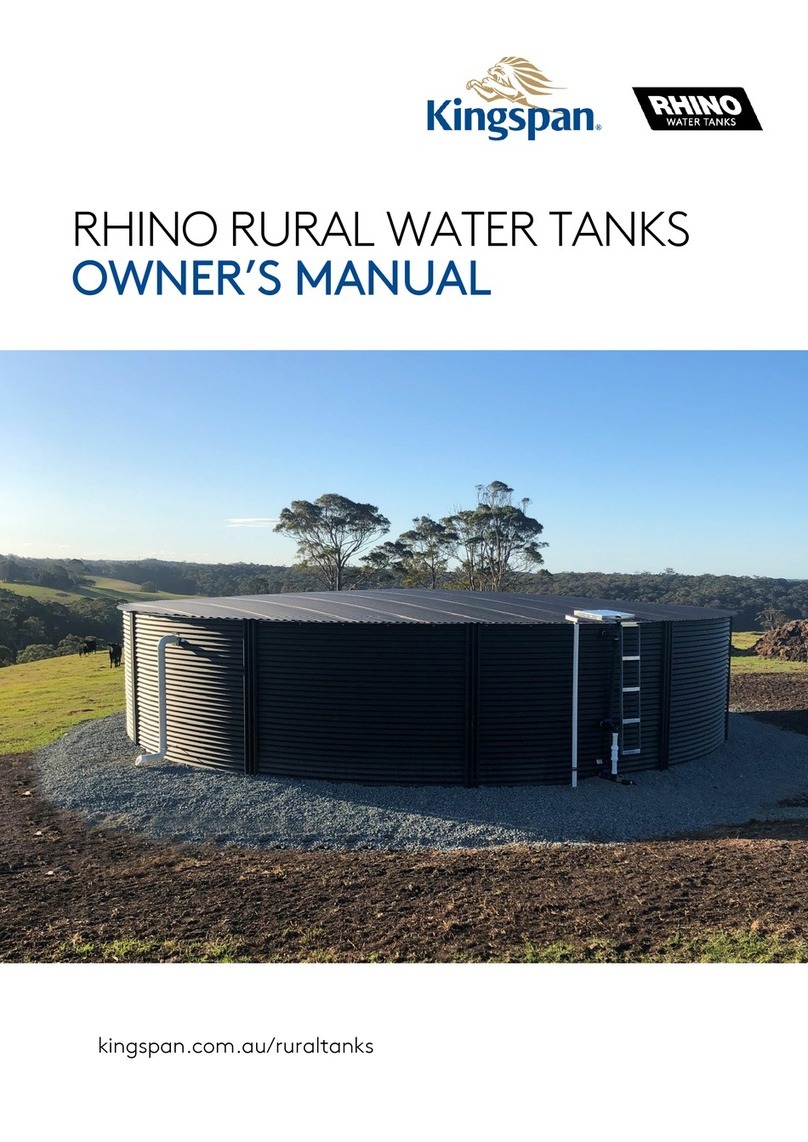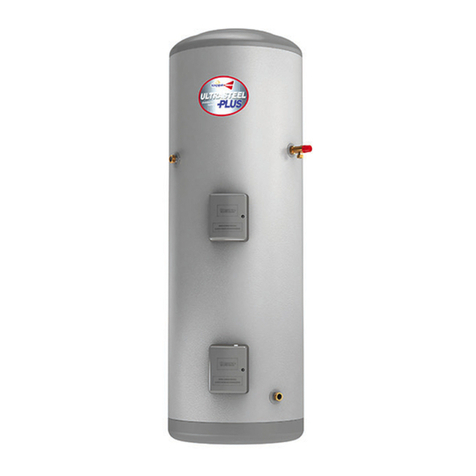7
DISCHARGE ARRANGEMENT
Position the inlet control group so that the discharge from both safety valves can be joined together via a 15mm end feed
Tee (see diagram above). Connect the Tundish and route the discharge pipe. The discharge pipework must be routed in
accordance with Part G3 of schedule 1 of the Building Regulations. The information that follows is not exhaustive and if you
are in doubt you should seek advice. The two safety valves will only discharge water under fault conditions. When operating
normally water will not be discharged. The tundish should be vertical, located in the same space as the unvented hot water
between the valve outlet and the tundish. The tundish should be positioned away from electrical devices.
Any Discharge should be visible at the tundish. The tundish should be located such that any discharge is visible. In addition,
where discharges from safety devices may not be apparent, e.g. people with impaired vision or mobility, consideration should
be given to the installation of a suitable safety device to warn when discharge takes place, e.g. electronically operated.
The discharge pipe (D2) from the tundish should:
A) Have a vertical section of pipe at least 300mm long, below the tundish before any elbows or bends in the pipework.
B) Be installed with a continuous fall of at least 1 in 200 thereafter.
The discharge pipe (D2) from the tundish should be of metal or other material that have been demonstrated to be capable of
withstanding temperatures of the water discharged.
The discharge pipe (D2) should be at least one pipe size larger than the nominal
outlet size of the safety device unless its total equivalent hydraulic resistance
exceeds that of a straight pipe 9m long i.e. discharge pipes between 9m and
18m equivalent resistance length should be at least two sizes larger than the
nominal outlet size of the safety device, between 18 and 27m at least 3 sizes
resistance. Refer to diagram 1, Table 1 and the worked example. An alternative
for design installation, testing and maintenance of services supplying water for
domestic use within buildings and their curtilages.
The discharge pipe (D2) should terminate in a safe place where there is no risk
to persons in the vicinity of the discharge. Examples of acceptable discharge
arrangements are:
seal.
b. Downward discharges at a low level; i.e. up to 100mm above external surfaces such as car parks,
hard standings, grassed areas etc. are acceptable providing that where children play or otherwise
come into contact with discharges, a wire cage or similar guard is positioned to prevent contact whilst
maintaining visibility.
c. Discharges at a high level; e.g. in to metal hopper and metal down pipe with the end of the
discharge pipe clearly visible or onto a roof capable of withstanding high temperature discharges of
water and 3m from any plastic guttering systems that would collect such discharges.
d. Device to warn when discharge takes place.
Note: The discharge will consist of
scalding water and steam. Asphalt,
rainwater goods may be damaged
by such discharges.
Note: D2 pipe from tundish is now
allowed to be installed in soil stacks
within premises. This activity is
not recommended by Kingspan as
discharge from T&P may continue
for long periods of time. It is the
installer’s responsibility to ensure
the discharge pipework can support
the discharge for prolonged periods.
If used follow guidance on
mechanical seal without water trap
given in G3 Building Regulations.
As discharge can be in excess of
90oC discharge into plastic pipework
is also not recommended.
Diagram of a typical discharge pipe arrangement (extract
from Building Regulation G3)
WORKED EXAMPLE
The example below is for G1/2 temperature relief valve with
a discharge pipe (D2) having 4 No. elbows and length of 7m
from the tundish to the point of discharge.
From Table 1:
Maximum resistance allowed for a straight length of 22mm
copper discharge pipe (D2) from a G1/2 temperature relief
valve is: 9.0m. Subtract the resistance for 4 No. 22mm
elbows at 0.8m each = 3.2m. Therefore the maximum
permitted length equates to: 5.8m. 5.8m is less than the
actual length of 7m therefore calculate the next largest size.
Maximum resistance allowed for a straight length of 28mm
pipe (D2) from a G1/2 temperature relief valve equates to:
14m. As the actual length is 7m, a 28mm (D2) copper pipe
will be satisfactory.
Table1
Sizing of copper discharge pipe ‘D2’ for a temperature
relief valve with a G1/2 outlet size (as supplied).
Size of
discharge
pipework
Maximum length of
straight pipe
(no bends or
elbows)
from the maximum length for
each bend or elbow in the
discharge pipe
22mm Up to 9m 0.8m
28mm Up to 18m 1m
35mm Up to 27m 1.4m


































